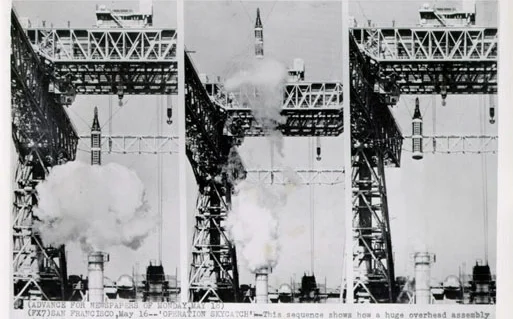






Hunters Point
Hunters Point
Hunters Point
Hunters Point
The Hunters Point Gantry crane is located in the Hunters Point Shipyard in San Francisco, CA. The commercial shipyard opened in 1867, housing the first permanent dry dock on the West Coast. Subsequent docks, built in 1916, were thought to be the largest in the world. At over 1000 feet in length, they were said to be big enough to accommodate the world's largest warships and passenger steamers.
In 1941, 11 days after the bombing of Pearl Harbor, the Navy bought the 47 acre shipyard from Bethlehem Steel Co. It eventually grew to 866 acres — 446 of which were underwater. At peak operation near the end of WWII, 18,000 men and women worked at Hunters Point.
The post-war shipyard saw the development of the Naval Radiological Defense Laboratory (NRDL), tasked with the study and decontamination of ships used in the nuclear weapons tests in the Marshall Islands. Top secret radiological defense and fallout research, waste disposal, and the repair of heavily radiated ships coming back from Bikini Atoll left a site that was heavy on contamination and low on documentation.

The Crane
The Crane
The Crane
The Crane
Construction of the gantry crane was completed in 1947. At 8,400 tons, it was the largest gantry crane in the world. Even then, its size was lost from a distance, as it stood astride the nation’s largest dry dock.
Nearly as long as the Titanic, it was billed as "The mightiest crane in the world." Two massive lifts moved along rails atop a 730 foot long runway. Over a 200 foot drop to the water, the crane's runway sat level with the roadway of the Golden Gate Bridge.
Originally developed to swap gun turrets on battleships, the crane’s record breaking 630 ton lifting capability and enormous size found a variety of applications.

Adaptation
Adaptation
In 1959, the 230 foot tall trapezoidal tower was added to the top of the crane, bringing its total height to nearly 500 feet. The addition was created to facilitate Operation Skycatch, where Polaris Missiles were fired and caught via a string of arresting cables, before being lowered to the ground for testing. Previous versions of the test had the missiles flung out into the bay and retrieved from the ocean floor.
In the 1960’s the U.S. Navy’s underwater laboratory, SEA-LAB, was built and tested in Hunters Point waters. In the photo above we see the underwater habitat that was used for both SEA-LAB I and SEA-LAB II, before being adapted to SEA-LAB III.

Decommissioning
Decommissioning
Decommissioning
Decommissioning
Though the NRDL was shut down in 1969, Hunters Point remained active until 1974, when it was decommissioned and placed on industrial reserve. In 1976, the majority of the land was leased to Triple A Machine Shop, Inc. who used it for ship repair.
On October 5, 1994, the US Navy was sued by a coalition of environmentalist, sports fishing, and public interest groups who alleged that toxic discharges from Hunters Point Naval Shipyard were contaminating San Francisco Bay. Though the alleged violations reached 19,000, the extent of the toxic mess buried on the south side of the base remains a mystery, largely due to the NRDL's shipshod documentation during their top secret research.

Today
Today
Today
Today
Today the crane sits derelict, the terminus of a lengthy dirt-covered pier, as Hunters Point is slowly churned up and developed around it. Decontamination has been a long, destructive process, wiping the landscape clean. But even as developers slowly close in around the crane, no plans yet call for its removal.
All current development initiatives see the Hunters Point Gantry Crane remaining as an iconic fixture on the bay for decades to come.
